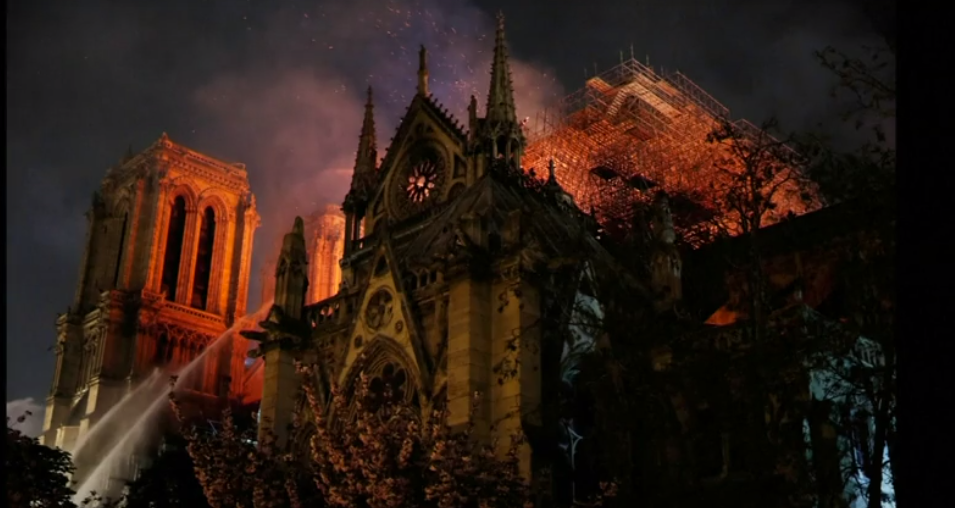
Notre-Dame of Paris ‘saved’ after fire destroys steeple

French firefighters on April 15 won an hours-long battle to save the main structure of Notre-Dame Cathedral in Paris, after a colossal fire caused the spire of the historic edifice to crash to the ground and wiped out centuries of heritage.
French President Emmanuel Macron vowed that “we will rebuild” Notre-Dame and expressed relief that “the worst had been avoided” in a fire that risked bringing the entire edifice down.
The fire destroyed the roof of the 850-year-old UNESCO world heritage landmark, whose spectacular Gothic spire collapsed before the eyes of horrified onlookers on a previously pristine early spring evening. The fire, which came as Catholics prepare to celebrate Easter, sent orange flames and clouds of grey smoke bill owing into the sky as stunned Parisians and tourists watched on in horror.
As darkness fell, some 400 firefighters then battled to control the fire and save at least its iconic front towers. They finally gained the upper hand as midnight approached. Paris fire brigade chief Jean-Claude Gallet said, “we can consider that the main structure of Notre-Dame has been saved and preserved” as well as the two towers.
Deputy Interior Minister Laurent Nunez, also present at the scene, said that for the first time “the fire had decreased in intensity” while still urging “extreme caution”. “This is really sad — the saddest thing I’ve ever stood and watched in my life,” said British tourist Sam Ogden, a 50-year-old onlooker, who had come to visit the cathedral with her family.

Gasps and cries of “Oh my god” erupted around an hour after the fire first broke out when the top portion of the church’s spire came crashing down. The cause of the blaze was not immediately confirmed. The cathedral had been undergoing intense restoration work which the fire service said could be linked to the blaze. French prosecutors said the blaze was being treated as an “involuntary” fire, indicating that foul play was ruled out for now.
Last week, dramatic footage had shown workers removing 16 copper statues from the spire which was undergoing a revamp financed by the state and private donors. Historians expressed incredulity at the collapse of a building that has been a symbol of France for almost a millennium and withstood war and revolution. ‘If Paris is the Eiffel Tower then France is Notre Dame. It’s the entire culture, entire history of France incarnated in this monument,” Bernard Lecompte, a writer and specialist in religious history told BFM TV.
Deputy Paris mayor Emmanuel Gregoire told the channel that workers were scrambling “to save all the artworks that can be saved.” Macron had earlier cancelled a major televised policy speech he was due to give on Monday evening to respond to months of protests, and instead headed to the scene in person. Visibly emotional, he said while the “worst had been avoided” and the facade and two towers saved “the next hours will be difficult”. Prime Minister Edouard Philippe said he felt a “sadness beyond words” but added the fire services “were still fighting… heroically, to save what can be saved”.
German Chancellor Angela Merkel called Notre-Dame cathedral a “symbol of European culture” as the blaze raged. The Vatican on Monday expressed its “incredulity” and “sadness”, expressing its “closeness with French Catholics and with the Parisian population.”
There was no immediate indication of any casualties in the blaze. US President Donald Trump in a tweet said it was “horrible” to watch the fire but caused controversy by offering advice on how to put it out. “Perhaps flying water tankers could be used to put it out. Must act quickly!” he said. But France’s civil security service, which oversees crisis management in the country, tweeted back at Trump that the use of water-bombing aircraft was not being considered. “If used, (this) could lead to the collapse of the entire structure of the cathedral,” it said.
Hundreds of people gathered on the bridges of Paris to witness the scene, many filming the images with their smartphones. The cathedral was located at the centre of the French capital in the Middle Ages and its construction was completed in the mid-12th century after some 200 years of work. During the French Revolution in the 18th century, the cathedral was vandalised in widespread anti-Catholic violence: its spire was dismantled, its treasures plundered and its large statues at the grand entrance doors destroyed.
It would go on to feature as a central character in a Victor Hugo novel published in 1831, ‘The Hunchback of Notre-Dame’ and shortly afterwards a restoration project lasting two decades got underway, led by architect Eugene Viollet-le-Duc. It would survive the devastation of two world conflicts in the 20th century and famously rang its bells on August 24, 1944, the day of the Liberation of Paris from German occupation at the end of the World War II.
“Paris is disfigured. The city will never be like it was before,” said Philippe, a communications worker in his mid-30s, who had biked over to the scene after being alerted of the fire by a friend. “It’s a tragedy,” he added. “If you pray, now is the time to pray.”

